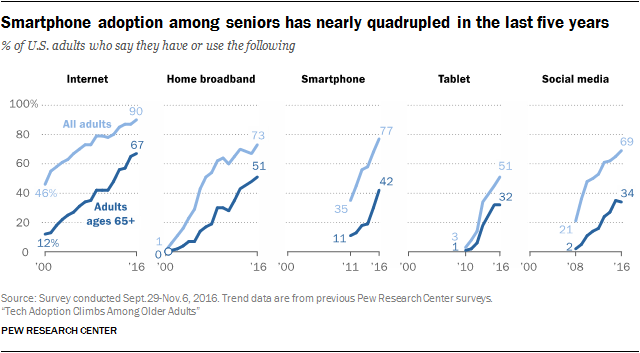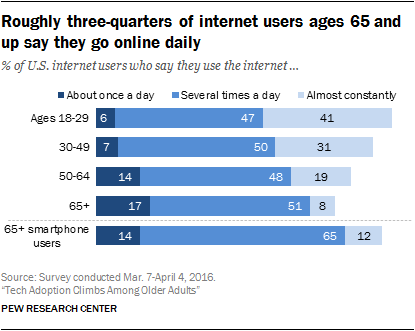I've been interested in "digital divide" questions since the 80's, with particular interest in the divide between the haves and have nots. I've been one of the lucky ones. Up until now, I landed on the "good side" of the divides.
Which is why is feels rather bizarre to read about the digital divide and realize, because of my age, I am teetering on the not-so-good side.
 I've harbored a secret guilt about not getting how to use Instagram, but I thought that was just me and my unwillingness to spend time learning it. After all, I've been an eLearning developer for longer than any in this class have been alive. I develop online courses for heaven's sake. I'm heavily involved with making computerware ADA Section 408 Compliant. Jeez!
I've harbored a secret guilt about not getting how to use Instagram, but I thought that was just me and my unwillingness to spend time learning it. After all, I've been an eLearning developer for longer than any in this class have been alive. I develop online courses for heaven's sake. I'm heavily involved with making computerware ADA Section 408 Compliant. Jeez!
But, in my off-the-clock life, I'm a pretty typical geezer, ah, Baby Boomer. I'm an information junkie who gets most of her information from the Internet, do all my banking and financial stuff on-line, and do all my non-Costco shopping on Amazon.
What does a smattering of research say about older internet and social media users?
According to Rainie and Wellman (2014) older adults are more likely to use the Internet for getting information and online banking. And buying things, and selling things. Older adults may not use social media because of concerns over privacy, perceived lack of digital literacy, and "digital skills."
Rainie and Wellman cite the Pew Research Groups data, indicating that the percentage of U.S. adults who send and receive text messages has risen 30% between 2006 and 2011, with 31% of U.S. adults sending and receiving texts in 2006. Interestingly, in persons ages 50-64, the rise was also 30%, but the starting percentage of this age group started at a bit over the total, at 18%. In 2011, texters in the 50-64 age group had risen to 48%, still lower than the total average of U.S. adults. Those aged 65 and up started at 3% and rose to 13%, well below the 30% growth of the 50-64 folks.
Note that the overall adoption of cell phones between the years of 2006 - 2011 was 30%. Those aged 50 - 64 increased their adoption of cell phones by 30% also, with ownership about the same level as the average U.S. adult. Again, those of age 65+, as a group owned fewer mobile phones, 55% vs. the 83% of U.S. adults on average.
If these numbers seem similar, it seems to me that sending text messages is a function of owning a mobile phone, and a "first function" of having a mobile phone may be to send text messages.
As the number of older adults owning mobile phones and texting increases, so does their time on the Internet.
The chart below provides information on the daily utilization of the internet by internet users. aged 65 and up.
Source:Anderson and Perrin, 2017 Barriers to Adoption and Attitudes Towards Technology,
Apparently once older adults get online, they revisit the internet often, roughly as often as other age groups, although the number who are on "almost constantly" appears to be 50% less than younger adults. Note that this data does not divide internet use between social media and the pursuit of non-socially mediated information.
The rate of older Americans using social media has kept a steady rise since 2008. See Perrin's 2015 article, Social Media Usage, 2005 - 2015 for the interactive version of this document.
Source: Social Media Usage, 2005 - 2015
Anderson and Perrin, in their 2017 publication, Tech Adoption Climbs Among Older Adults confirm that older Americans are making significant advances in internet use and social media, and own the means for making this happen. However, this data indicates that there are a large number of older Americans who are not on the internet, especially not on social media.
 Source: Tech Adoption Climbs Among Older Adults
I would like to put out a suggestion as to why more older Americans, 65+, are using the internet and social media. MIght it be that some of these individuals have retired, and have more time for personal information seeking? Perhaps some of these individuals have raised their families, and may have more time to spend on social media (perhaps checking up on adult children and grandchildren)? These may be reasons for the increased reported use of the internet and social media among older Americans.
Source: Tech Adoption Climbs Among Older Adults
I would like to put out a suggestion as to why more older Americans, 65+, are using the internet and social media. MIght it be that some of these individuals have retired, and have more time for personal information seeking? Perhaps some of these individuals have raised their families, and may have more time to spend on social media (perhaps checking up on adult children and grandchildren)? These may be reasons for the increased reported use of the internet and social media among older Americans.
Why are some older Americans not using the internet and social media?
While many older individuals are computer users, why are the stats almost always lower for older users as a whole?
I took a quick, decidedly non-scientific poll of my 65+ friends at the dog park this morning, asking who used the internet and social media. All answered that they used the Internet for information and used social media to check up on their kids. Few, however, used social media themselves, citing privacy concerns. (Thereby showing some degree of computer literacy)
As the conversation continued, the quip about needing your grandkid to set up the computer and mobile phone came up. This stereotype may have some basis in truth.

Along with difficulty getting hardware and software to work, some older adults have trouble with digital skills, such as keyboarding. While it is likely that younger students developed keyboarding skills at a young age, older persons may have had their first keyboarding lessons in high school. While younger persons may have continually developed their keyboarding skills, older adults may have had limited practice in the skills they did have.
At this point in history, keyboarding is considered a basic job skill. Classes in keyboarding are common in workforce development curricula.
This was not always the case.
In the early days of 2000, I taught keyboarding as a part of a Computer Applications in Education. Most of my keyboarding students were upper level administrators who had, or who recently had had, secretaries to type for them. For most, keyboarding was a challenge. Ten years later, I was coaching senior-level surgeons in using electronic medical charts - keyboarding was an even greater challenge.
It seemed to me, after these experiences, that the more advanced the position, the less keyboarding skills were practiced on a regular basis. As that portion of the workforce has aged and retired, perhaps internet and social media use in individuals has not increased for some because of keyboarding activities.
In addition to lack of keyboarding skills, comfort while keyboarding may be a factor. Those who have had metacarpal tunnel issues can confirm how painful it can be to keyboard with a wrist injury. Fortunately, there are easily obtained braces for making keyboarding with metacarpal tunnel disorder much more comfortable.
This is not a option for individuals with arthritis in their hands, either osteoarthritis or rheumatoid arthritis. Keyboarding can be uncomfortable, to the point of being disabling, to those with arthritis. Osteoarthritis, the "wear and tear" kind often found in older persons, can limit the ability to effectively use a computer. See Baker, et al., 2009 Problems experienced by people with arthritis when using a computer.
It is not difficult to see the benefit of using the internet and social media into older adulthood. For me, the greatest benefit to older adults is the likelihood of cognitive benefits. Kelli Quinn's 2018 publication,
Cognitive Effects of Social Media Use: A Case of Older Adults, provides research indicating that cognitive ability in older adults is correlated with social connectedness. Because, over time, the social circle of the typical older person shrinks. Retirement may take away relationships at work. Families whose children have grown may move away. Friends, family and spouses may die. Facebook time can replace f-2-f social relationships to a degree, and, it appears, can protect against age-related cognitive deterioration. In addition to social networking, other uses of the internet appear to support cognitive flexibility. Undertaking
a variety of internet activities (not a variety of "brain games") appears to be correlated with maintaining cognitive flexibility.
Some summary thoughts...
- The idea that older adults are not active on the internet and social media may be something of a myth.
- Older Americans are increasing their use of the internet and social media at a pretty good clip. Perhaps retiring from the workforce plays a part of this.
- Facebook might be more important than we think for the health of older individuals.
- While commercial "brain games" may be of dubious value, completing a variety of "real" tasks on a computer appear to promote cognitive flexibility.
- If your hands hurt, you might not be on the internet nor social media. Osteoarthritis (quite common in older adults), rheumatoid arthritis and other forms of the disease are recognized as disabling for computer users.
- Older individuals are likely to need help in learning how to set up and use equipment and software. Got an older friend or relation? Offer to help set his or her computer. Karma, baby, karma.






